Make a Love Connection: Biophilia in the North Cascades
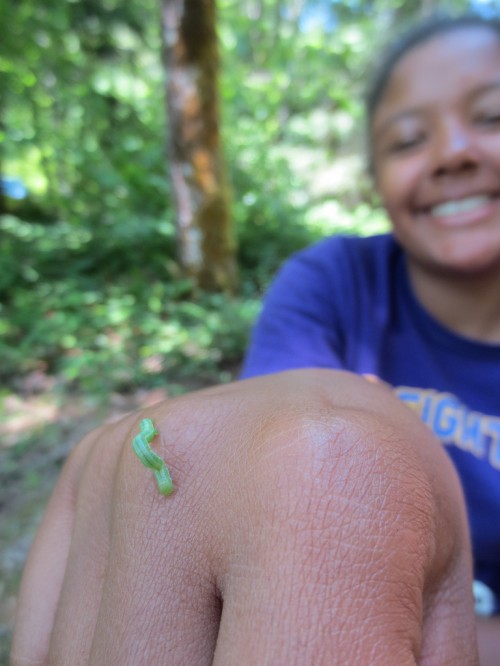
Five pairs of fifth graders are scattered on the Buster Brown Trail. In each pair, one is blindfolded with a colorful bandana, being carefully – the teacher hopes — led in a circuitous route by their partner.
“Remember, when you start to head off the trail toward your tree, make sure to not step where other people are stepping, and try hard to avoid the plants!” This is what I, or another Mountain School instructor, will inevitably say, loving this lesson but feeling the nagging omnipotence of the leave-no-trace ethic.
The students are mindful, taking care to not crunch the Mahonia and Salal understory. The blindfolded student is led to a tree. Maybe it’s a Doug fir, with its thick “bacon” bark (or akin to the cracked top of a pan of brownies, for the vegetarians). Other naturalists tell me bats can roost in there, when the tree is old and the bark is deeply furrowed, though I haven’t been lucky enough to encounter that yet. Perhaps the student is escorted to a paper birch, its thin, peeling bark being a telltale give-away of its arboreal identity. There’s always the vine maple, as well, dressed in moss and reaching from the mid-story canopy with its flexible, green branches.
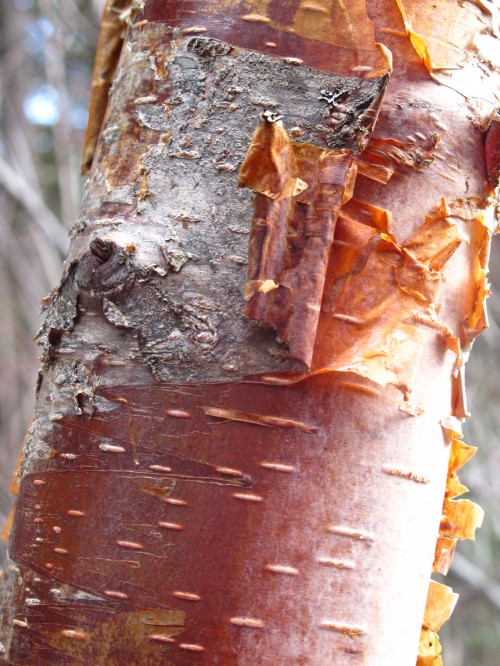 Could you tell this tree with your eyes closed? Photo by Katherine Renz.
Could you tell this tree with your eyes closed? Photo by Katherine Renz.
“Okay, start heading back to the trail!” After five or ten minutes, the students reconvene briefly to trade bandanas and head out a second more time. I enjoy watching them “meet a tree”, as this exercise is called. They use only touch, smell, taste and hearing – and these last two are arguable since, respectively, I don’t encourage students to eat unidentified plants, and the trees aren’t usually feeling loquacious. Can you find your tree? It’s a fantastic lesson in sensory awareness, considering it activates four of most peoples’ less dominant senses. What does your tree feel like? What about the plants at the base of the trunk? If you hug it, can your hands connect? Is there a smell if you scrape at the bark a little or crunch the leaves? If you knock on the trunk, does it make a notable sound? What did the ground feel like beneath your feet as you were led, without sight, through the fallen logs and leaf litter of the understory?
We come back together in a circle, everyone’s eyes open, and “debrief” the details the students relied upon to find or, sometimes, not find, their tree. This is one of my favorite lessons, and the students tend to recall it fondly as well. On the evaluation sheets their classroom teachers fill out at the end of the three days, they usually rave about it, saying it helps open their students up to a deeper level of observation, care, and empathy for the natural world.
Meet a Tree: Yes, you can try this at home.
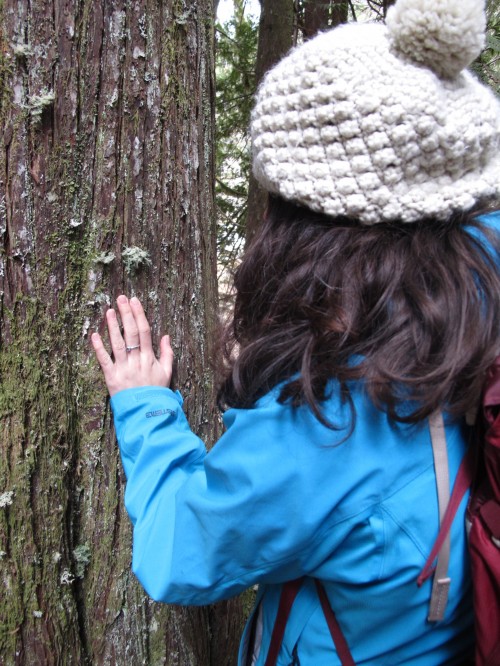 Graduate student and Bostonian Samantha Hale gets in touch with her West Coast side, meeting this lichen-covered Western red cedar at Mt. Rainier National Park. Photo by Katherine Renz.
Graduate student and Bostonian Samantha Hale gets in touch with her West Coast side, meeting this lichen-covered Western red cedar at Mt. Rainier National Park. Photo by Katherine Renz.
In Mountain School, instructors are constantly breaking down science-y words with the students into their component, literal parts. Bio = life, and philia = love.
Pulitzer Prize winning author Edward O. Wilson publicized his “Biophilia Hypothesis” back in 1984 (which may seem an appropriate counter-balance to the George Orwell scholars among us, no?). The entomologist and Harvard professor argued that humans have an innate bond with other species, and this is at the core of our humanity. In his short book, titled Biophilia, Wilson presents a conservation ethic based on this natural kinship with all creation, a poetic plea for protecting biodiversity, a sequel of sorts to Aldo Leopold’s A Sand County Almanac.
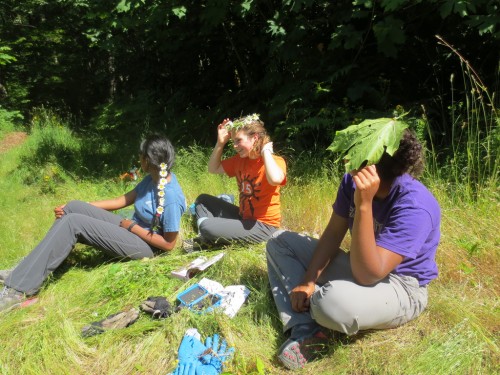 Youth Leadership Adventures group, “the Diablo Divas”, take a break from stewardship activities last summer and bond with the botanical. Photo from NCI Archives.
Youth Leadership Adventures group, “the Diablo Divas”, take a break from stewardship activities last summer and bond with the botanical. Photo from NCI Archives.
Is Wilson’s hypothesis true? Of course, as an environmental educator, the tendency is to immediately gush, “Duh, of course it is!”. When I get my head out of the clouds, though, from my perch in the rather isolated North Cascades, I have to wonder. Based on the shabby state of the planet, it sure doesn’t look like it.
But Wilson is a biologist, one who has received multiple prestigious awards in the scientific community. A blindly optimistic, effusive, say, nature writer or cheerleader he is not. Allow this quote from Biophilia at length, as he can explain the foundation of his hypothesis best:
“…We are human in good part because of the particular way we affiliate with other organisms. They are the matrix in which the human mind originated and is permanently rooted, and they offer the challenge and freedom innately sought. To the extent that each person can feel like a naturalist, the old excitement of the untrammeled world will be regained. I offer this as a formula of reenchantment to invigorate poetry and myth: mysterious and little known organisms live within waking distance of where you sit. Splendor awaits in minute proportions.”
And later: “Natural philosophy has brought into clear relief the following paradox of human existence. The drive toward perpetual expansion – or personal freedom – is basic to the human spirit. But to sustain it we need the most delicate, knowing stewardship of the living world that can be devised. Expansion and stewardship may appear at first to be conflicting goals, but they are not. The depth of the conservation ethic will be measured by the extent to which each of the two approaches to nature is used to reshape and reinforce the other. The paradox can be resolved by changing its premises into forms more suited to ultimate survival, by which I mean protection of the human spirit.”
Ba-bam! The point of environmental education, tidily in two paragraphs.
Returning to the blindfolded Mountain Schoolers getting to know their trees, I’m reminded of something from another environmental luminary’s book, The Nature Principle by Richard Louv (coiner of the term, “nature-deficit disorder”). He quotes Elaine Brooks, an educator from La Jolla, CA, who believes that the vegetation that surrounds us “for any length of time completes a kind of transkingdom emotion graft”. Do the students get grafted while they’re here, form an irrevocable bond with kingdoms Plantae and Fungi? Independence and interdependence – Wilson’s “expansion and stewardship”, biophilia in action.
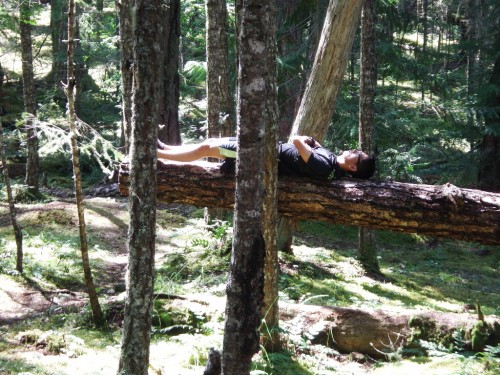 A Youth Leadership Adventures participant gets a “transkingdom emotion graft” and a nap. Photo from NCI Archives.
A Youth Leadership Adventures participant gets a “transkingdom emotion graft” and a nap. Photo from NCI Archives.
Some advice for this February 14, and beyond:
Protect your spirit.
Expand and steward.
Affiliate.
Meet a tree.
Seek challenge and freedom.
Fall in love over and over again.
Being a naturalist is so the best.
Happy Valentine’s Day!
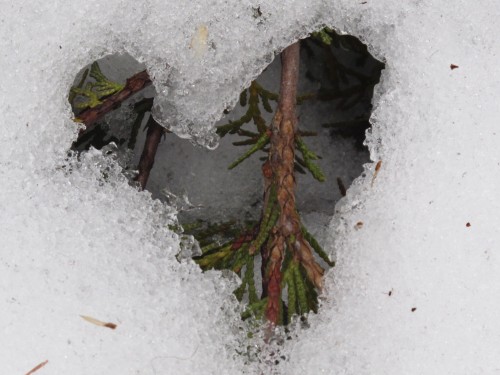
Katherine Renz is a graduate student in North Cascades Institute and Western Washington University’s M.Ed. program. She hopes your Valentine’s is filled with love, whatever that means for you.


Great piece, Katherine. We need more of this positive thinking. Thank you.